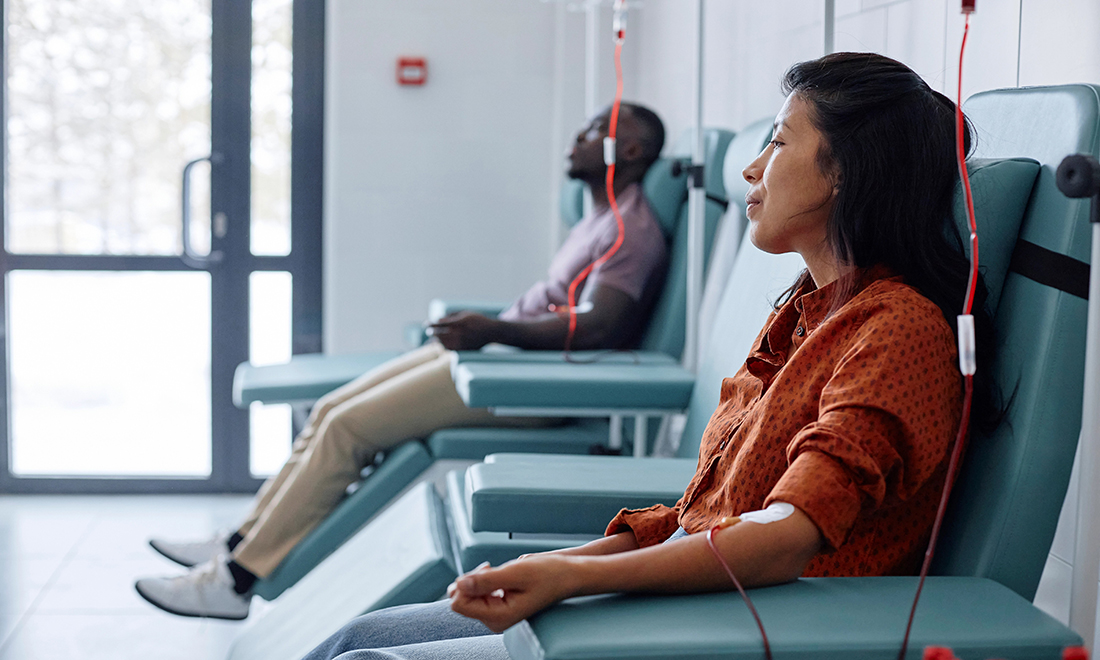
作為英國一項臨床試驗的一部分,科學家已經安全地將實驗室培育的血液輸注給人類,這是世界首例。
這一壯舉是劍橋大學(University of Cambridge)和布里斯托爾大學(University of Bristol)的科學家以及英國國家醫療服務體系(National Health Service)的研究人員正在進行的一項研究的一部分,該研究將實驗室培育的血液與來自同一捐獻者的標準血液的壽命進行比較。
它是否安全?
這項研究背后的研究團隊在11月7日宣布,人造血細胞是由從捐獻者身上采集的干細胞培育而成的,到目前為止已經被輸入兩個人體內。
科學家們說,這標志著實驗室培育的血細胞首次被輸到一個人體內,而受血者并不是捐獻者。
大約一茶匙到兩茶匙,或5毫升到10毫升的實驗室培育的血液被輸到參與者體內。在常規輸血中,病人要輸的血比這多得多。
研究人員指出,受血者受到嚴密的監控,沒有出現“不良”副作用的報告。專家說:“他們都很好,也很健康。”
隨著試驗的進行,至少10名參與者將接受兩次“迷你輸血”,一次是實驗室培育的血液,另一次是標準的捐獻血液,兩次輸血將至少間隔四個月。
科學家們將分析實驗室中培育的“年輕”紅細胞是否比體內產生的細胞壽命更長。
比“真”血更好?
輸血可以挽救生命,適用于各種情況,從治療分娩后或嚴重事故大出血的人,到治療鐮狀細胞病和某些類型的癌癥患者。
參與這項研究的專家表示,由于實驗室培育的血細胞都是新的,而直接從捐獻者那里采集的血液是由不同年齡的捐獻者的細胞組成的,他們預計實驗室培育的血液壽命更長。
布里斯托爾大學的阿什利·托伊教授和英國國家醫療服務體系血液和移植研究部(NHS Blood and Transplant)在一段概述該試驗及其目標的視頻中說,由于實驗室培育的細胞“非常新鮮,能夠隨時使用”,因此研究團隊希望實驗室培育的細胞表現會更好。
有可能“徹底改變”治療方法
研究人員于11月7日承認,在實驗室培育的血液被推廣醫用之前,還需要進行進一步的試驗,但他們表示,他們的研究標志著使用實驗室培育的血液來改善“復雜輸血需求”患者的治療方法邁出了“重要”一步。
他們在一份新聞稿中說:“如果被證明是安全有效的,人造血細胞就可以徹底改變血液疾病患者的治療方法,例如鐮狀細胞病和稀有血型患者。”
“對于一些患有這些疾病的人來說,可能很難找到足夠的匹配的捐獻血液。此外,如果人造細胞在體內的存活時間更長,經常需要輸血的患者可能就不需要那么頻繁地輸血了。這將減少頻繁輸血導致的鐵超載,而鐵超載可能會導致嚴重的并發癥。”
英國國家醫療服務體系血液和移植部的輸血醫學主任法魯克·沙阿于11月7日在一份聲明中解釋稱,需要定期或間歇性輸血的患者會產生針對稀有血型的抗體,從而更難找到能夠輸血給這些人而又不會造成潛在威脅生命的反應的供血。
她說:“這項世界領先的研究為制造紅細胞奠定了基礎,這種紅細胞可以安全地用于給鐮狀細胞病等疾病患者輸血。絕大多數輸血仍然需要正常獻血。但是這項工作使難以接受輸血的病人受益的潛力非常大。”
英國鐮狀細胞病協會(Sickle Cell Society)的首席執行官約翰·詹姆斯在一份聲明中指出,雖然這項研究提供了“真正的希望”,但重要的是要記住,英國國家醫療服務體系仍然依賴每天250人獻血來治療鐮狀細胞病患者。
他說:“絕大多數輸血仍然需要正常獻血。”(財富中文網)
譯者:中慧言-王芳
作為英國一項臨床試驗的一部分,科學家已經安全地將實驗室培育的血液輸注給人類,這是世界首例。
這一壯舉是劍橋大學(University of Cambridge)和布里斯托爾大學(University of Bristol)的科學家以及英國國家醫療服務體系(National Health Service)的研究人員正在進行的一項研究的一部分,該研究將實驗室培育的血液與來自同一捐獻者的標準血液的壽命進行比較。
它是否安全?
這項研究背后的研究團隊在11月7日宣布,人造血細胞是由從捐獻者身上采集的干細胞培育而成的,到目前為止已經被輸入兩個人體內。
科學家們說,這標志著實驗室培育的血細胞首次被輸到一個人體內,而受血者并不是捐獻者。
大約一茶匙到兩茶匙,或5毫升到10毫升的實驗室培育的血液被輸到參與者體內。在常規輸血中,病人要輸的血比這多得多。
研究人員指出,受血者受到嚴密的監控,沒有出現“不良”副作用的報告。專家說:“他們都很好,也很健康。”
隨著試驗的進行,至少10名參與者將接受兩次“迷你輸血”,一次是實驗室培育的血液,另一次是標準的捐獻血液,兩次輸血將至少間隔四個月。
科學家們將分析實驗室中培育的“年輕”紅細胞是否比體內產生的細胞壽命更長。
比“真”血更好?
輸血可以挽救生命,適用于各種情況,從治療分娩后或嚴重事故大出血的人,到治療鐮狀細胞病和某些類型的癌癥患者。
參與這項研究的專家表示,由于實驗室培育的血細胞都是新的,而直接從捐獻者那里采集的血液是由不同年齡的捐獻者的細胞組成的,他們預計實驗室培育的血液壽命更長。
布里斯托爾大學的阿什利·托伊教授和英國國家醫療服務體系血液和移植研究部(NHS Blood and Transplant)在一段概述該試驗及其目標的視頻中說,由于實驗室培育的細胞“非常新鮮,能夠隨時使用”,因此研究團隊希望實驗室培育的細胞表現會更好。
有可能“徹底改變”治療方法
研究人員于11月7日承認,在實驗室培育的血液被推廣醫用之前,還需要進行進一步的試驗,但他們表示,他們的研究標志著使用實驗室培育的血液來改善“復雜輸血需求”患者的治療方法邁出了“重要”一步。
他們在一份新聞稿中說:“如果被證明是安全有效的,人造血細胞就可以徹底改變血液疾病患者的治療方法,例如鐮狀細胞病和稀有血型患者。”
“對于一些患有這些疾病的人來說,可能很難找到足夠的匹配的捐獻血液。此外,如果人造細胞在體內的存活時間更長,經常需要輸血的患者可能就不需要那么頻繁地輸血了。這將減少頻繁輸血導致的鐵超載,而鐵超載可能會導致嚴重的并發癥。”
英國國家醫療服務體系血液和移植部的輸血醫學主任法魯克·沙阿于11月7日在一份聲明中解釋稱,需要定期或間歇性輸血的患者會產生針對稀有血型的抗體,從而更難找到能夠輸血給這些人而又不會造成潛在威脅生命的反應的供血。
她說:“這項世界領先的研究為制造紅細胞奠定了基礎,這種紅細胞可以安全地用于給鐮狀細胞病等疾病患者輸血。絕大多數輸血仍然需要正常獻血。但是這項工作使難以接受輸血的病人受益的潛力非常大。”
英國鐮狀細胞病協會(Sickle Cell Society)的首席執行官約翰·詹姆斯在一份聲明中指出,雖然這項研究提供了“真正的希望”,但重要的是要記住,英國國家醫療服務體系仍然依賴每天250人獻血來治療鐮狀細胞病患者。
他說:“絕大多數輸血仍然需要正常獻血。”(財富中文網)
譯者:中慧言-王芳
Lab-grown blood has safely been given to humans via transfusions as part of a British clinical trial, an achievement being hailed as a world first.
The feat came as part of an ongoing study being carried out by scientists at the universities of Cambridge and Bristol as well as researchers from the U.K.’s National Health Service (NHS), which is comparing the life span of lab-grown blood with standard blood that has come from the same donor.
Is it safe?
The manufactured blood cells—grown from stem cells that were collected from donors—have so far been transfused into two people, the research team behind the study announced on November 7.
It marks the first time lab-grown blood cells have been put into the body of someone who is not the donor of the cells from which the blood was grown, scientists said.
Around one to two teaspoons, or 5 to 10 milliliters, of lab-grown blood was transfused into the participants. In a regular blood transfusion, patients are given much more blood than this.
The recipients of the blood were being closely monitored, researchers noted, and no “untoward” side effects had been reported. “They are well and healthy,” experts said.
At least 10 participants will receive two “mini transfusions” of blood—one consisting of lab-grown blood, one of standard donated blood—as the trial progresses, which will be given a minimum of four months apart.
Scientists will analyze whether the “young” red blood cells made in the lab last longer than cells made in the body.
Better than “real” blood?
Blood transfusions can be lifesaving procedures and are used in various circumstances, from treating people who have suffered severe bleeding after childbirth or a serious accident to treating those with sickle cell disease and certain types of cancer.
Experts working on the study said that because the lab-grown blood cells were all new, while blood collected directly from donors was made up of cells of varying ages, they expected the lab-grown blood to have longer life spans.
In a video outlining the trial and its aims, professor Ashley Toye of the University of Bristol and NHS Blood and Transplant’s research unit said the team was hopeful that because the lab-made cells were “so freshly made and ready to go,” they would perform better.
Potential to “revolutionize” treatments
Researchers acknowledged on November 7 that further trials were needed before lab-grown blood could be rolled out for medical use, but they said their study marked a “significant” step toward using it to improve treatments for patients with “complex transfusion needs.”
“If proved safe and effective, manufactured blood cells could in time revolutionize treatments for people with blood disorders such as sickle cell and rare blood types,” they said in a press release.
“It can be difficult to find enough well-matched donated blood for some people with these disorders. Additionally, if manufactured cells last longer in the body, patients who regularly need blood may not need transfusions as often. That would reduce iron overload from frequent blood transfusions, which can lead to serious complications.”
Farrukh Shah, medical director of transfusion for NHS Blood and Transplant, explained in a statement on November 7 that patients who need regular or intermittent blood transfusions can develop antibodies against minor blood groups, making it more difficult to find donor blood that can be transfused into those individuals without the risk of a potentially life-threatening reaction.
“This world-leading research lays the groundwork for the manufacture of red blood cells that can safely be used to transfuse people with disorders like sickle cell,” she said. “The need for normal blood donations to provide the vast majority of blood will remain. But the potential for this work to benefit hard-to-transfuse patients is very significant.”
John James, chief executive of the U.K.’s Sickle Cell Society, said in a statement that while the research offered “real hope,” it was important to remember that Britain’s NHS still relied on 250 blood donations per day to treat people with sickle cell disorder.
“The need for normal blood donations to provide the vast majority of blood transfusions will remain,” he said.






